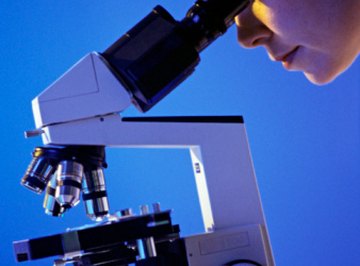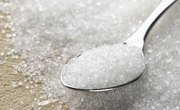
In chemistry, osazones are a type of carbohydrate derived from different sugars. Osazones are formed when the sugars react with a compound known as phenylhydrazine at boiling point. The technique was developed by Emil Fischer, a German chemist, to identify different sugars. Fischer was able to differentiate the types of sugar by studying the crystals that formed from his procedure.
Osazone Types
Osazone crystals can be best studied using a microscope, with which it is easy to see the types of crystals that are formed from the different sugars. The types of crystal vary quite significantly -- some resemble the petals of flowers, others are more like cotton wool balls, while others are more like balls of needles or even look like long, fine needles. Sucrose, however, does not form osazone crystals, as it is a non-reducing sugar.
Crystal Types
Sugars known as disaccharides include maltose, lactose and sucrose. The first presents osazone crystals that are shaped liked sunflowers, while lactose osazone crystals are more akin to tight balls of needles. Arabinose also produces an osazone crystal like a ball, but it is a less dense formation of needles than the lactose crystal. Monosaccharides, however, are simpler sugars that include glucose, fructose and mannose, and these produce needle-shaped osazone crystals.
Making Osazone Crystals
Phenylhydrazine reacts with the carbonyl in the sugar to create phenylhydrazone. The hydrazones then react further with the phenylhydrazine to produce insoluble osazones that appear in crystal form. The difference in the structure of the monosaccharides is caused by the diverse groups attached to the first and second carbons of the sugar molecules. Their needle-shaped crystals show that the position of the first and second carbons do not matter in the crystal formation.
Time to Form
The time needed to create osazone crystals varies among the various sugars involved, but helps to identify the sugars being tested. For an osazone crystal to be presented from a hot solution will take as long as follows: fructose, two minutes; glucose, four to five minutes; xylose, seven minutes; arabinose, 10 minutes; galactose, 15-19 minutes; raffinose, 60 minutes; lactose, osazone soluble in hot water; maltose, osazone soluble in hot water; mannose, 30 seconds.
References
About the Author
Martin Laing has been writing professionally since 1980. He is an experienced journalist whose work appears in a variety of newspapers and magazines, including "The Herald," "The Scotsman" and "Prestige" magazine in southeast Asia. Laing earned a diploma in journalism from Napier University, Edinburgh.
Photo Credits
Jupiterimages/liquidlibrary/Getty Images
